In this blog post, Shambhavi Kumar, a student of Jindal Global Law School, Sonipat, provides an overview on the acts pertaining to the dispersal of unlawful assemebly.

Introduction
Article 19(1)(b)[1] of the Indian Constitution confers onto the citizens the right to assemble. However, there is always a possibility that an assembly might turn unruly, causing damage not only to property but also to life. Such an unruly assembly is termed as “unlawful assembly.”
This paper aims to discuss the methods of dispersal of an unlawful assembly and in the process; it explores what exactly constitutes an unlawful assembly as well as steps taken for prevention of such an assembly.
Unlawful Assembly
Section 141[2] in The Indian Penal Code defines “unlawful assembly.” The following are the ingredients for an assembly to be labelled as an “unlawful assembly”: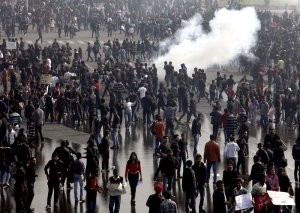
Assembly of five or more persons: There must necessarily be more than four persons sharing the common object. When there is no evidence to prove that the fifth individual shared the same object; it cannot be considered an unlawful assembly with the remaining four persons.
In the case of Amar Singh v. State of Punjab[3], at the onset, seven people had been charged under Sections 148[4] and 149[5] Of the Indian Penal Code. The Sessions Court acquitted two of the accused and another by the High Court. No one other than these seven was mentioned to have been involved in the crime. The conviction of the remaining four was held not to be sustained. Hence, the acquittal of three of the accused people led to the remaining four to not be convicted under the Sections 148 or 149. The identity of all the members of such an assembly does not necessarily need to be established.
Existence of a common object among all the members which they should be aware of: They must have knowledge of it and agree to it. There should be a present and immediate purpose to carry out the common object. There does not need to be evidence of premeditation or preparation to impute a common object on the Explanation to Section 141 of the Criminal Procedure Code. The common object, however, must be discovered. Common object as required by Section 141 is not the same as that required by Section 34. In this regard simply being present with members of an unlawful assembly isn’t enough to prove that he or she had the same common object as the unlawful assembly. Other direct or circumstantial evidence must be there to justify the existence of a common object.
The common object can be inferred by observing the conduct of the said assembly. This includes the nature of the assembly, the arms used by them as well as its behaviour at the scene of occurrence or before it.
In Lallan Rai and Ors v. State of Bihar[6] The Court held that the requirement of the law is that the person who has the common object must be present at the place of occurrence.
The common object of the assembly should qualify for at least one of the five that are mentioned in section 141:
(a) Overawing by use of criminal force: Overawing by superior influence or by fear is not illegal. It is termed illegal only when accompanied by a show of criminal force. When a person is frightened into doing something that he, otherwise, would not do or refrain from doing what he otherwise would do; he is thought to be overawed. The show of force caused by this fear is termed to be overawed by the show of criminal force.
For this clause to be applicable, it is necessary for the assembly to have the common object to overawe, simply having the effect of overawing does not attract its application.
(b) Resisting legal process: Any resistance to the implementation of the provisions of law or the carrying out of any legal process is considered to be illegal. If the common object of an assembly is perfectly legal, then it cannot be deemed to be illegal.
(c) Committing “Mischief” or “Criminal Trespass”: Section 425[7] and 441[8]of the Indian Penal Code define the terms “mischief” and “criminal trespass” respectively. “Offense”[9] means something punishable, either under the Code or any local or special law with imprisonment for six months or upward, with or without fine. The restriction defining the minimum punishment is applicable only to offenses under the local or special law.
If a group of seven boys illegally seizes a herd of goats and leads it to a nearby lake, they cannot be said to be a part of an unlawful assembly their act does not qualify as mischief or as any of other offense stipulated in the clause.
(d) Taking or obtaining of criminal force possession of the property by use: No one is to vindicate his or her right to possess any property by recourse to criminal force. This right is subjected to limitations mentioned in Sections 97[10] to 106[11] Of the Indian Penal Code. It is available against offenses only, not against any lawful act.
In cases where the right is only in doubt, it becomes necessary to recourse, to force, to protect it; this clause would apply, and any assembly gathered to further such a purpose would be considered an “unlawful assembly.”
(e) Compelling any person using criminal force into doing something he is not legally bound to do: This is a very comprehensive clause and applies to all rights possessed by a man, irrespective of whether they do or do not concern enjoyment.
Explanation: An assembly may be lawful at the time of its inception but may subsequently turn unlawful. This turn of events occurs the moment one member calls on others to assault X and in response, the rest of the party starts chasing X who was running away from them. No proof of preparation or premeditation is necessary to impute a common object to members of an unlawful assembly.
Section 143[12]of the Indian Penal Code lays down the punishment for the members of an unlawful assembly.
Dispersal
The dispersal of such an assembly is dictated by Sections 129, 130, 131 and 132 of the Code of Criminal Procedure, 1973.
Section 129 describes the dispersal of assembly by use of civil force.
“(1) Any Executive Magistrate or officer in charge of a police station or, in the absence of such officer in charge, any police officer, not below the rank of a sub-inspector, may, command any unlawful assembly or any assembly of five or more persons likely to cause a disturbance of the public peace, to disperse; and it shall thereupon be the duty, of the members of such assembly to disperse accordingly.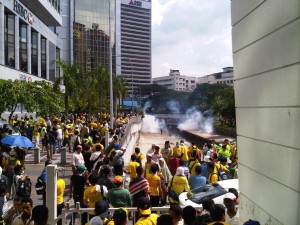
(2) If, upon being so commanded, any such assembly does not disperse, or if, without being so commanded, it conducts itself in such a manner as to show a determination not to disperse, any Executive Magistrate or police officer referred to in sub-section (1), may proceed to disperse such assembly by force, and may require the assistance of any male person, not being an officer or member of the armed forces and acting as such, for the purpose of dispersing such assembly, and if necessary, arresting and confining the persons who form part of it, in order to disperse such assembly or that they may be punished according to law.”
Hypothetical Examples
Recently, the town of Jhagdapur witnessed incidences of communal violence between Muslims and Hindus residing in that area. Not many days after the last recorded incident, in the neighbouring town, Mirkat, about 50 kilometres away from Jadgapur, a group of twelve Hindu boys, all carrying hockey sticks were marching up to a residential area occupied mostly by Muslims. The officer in charge of Mirkat Thana, the closest police station, ordered this group to disperse. According to Section 129(a), it is the duty of the members of this assembly to disperse which they did to avoid being forced to disperse and getting arrested or confined by the police.
On a given date, a group of 60-70 protesters demonstrating against an allegedly corrupt politician, accused of having a wealth of black money, marched towards his residence shouting and carrying posters bearing the slogan “Kala dhan wapas karo warna hum khud hi le lenge” (“return the black money or else we will take it back ourselves”). The protesters settled outside the said politician’s residence and showed no signs of dispersing. After a few hours, around 8-9 of the protestors picked up stray stones and rocks from the roadside and started flinging them at the house causing damage to the property. The rest of the protesters continued chanting their slogan while more of them joined the pelters and showed no signs of dispersing. At this, the police monitoring the area resorted to baton charge or lathi charge to disperse the crowd. Persons who were pelting the stones at the residence were arrested by the police to be punished according to the law.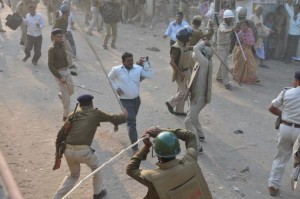
In this case, the use of force for dispersal of the assembly by the police is justified as the members, more than 5, had a common object which was illegal, i.e., mischief on account of damage to the property, rendering the assembly as unlawful. The fact that rest of the protestors continued sitting and chanting showed the unwillingness of the assembly to disperse. Hence, Section 129(b) is applicable for dispersal of such an assembly.
If in the same case, the protestors had not flung stones and not damaged property then the similar action of the police would not be justified as the peaceful assembly could not be classified as an unlawful assembly as under Section 141.
Cases
In the case, Nagraj v State of Mysore[13], a Sub-Inspector of Police in Mysore State was alleged to have severely beaten a person X, and when requested by Y to excuse X while forcibly taking him away, fired at two people. The appellant, the sub-inspector, claimed that while he along with a constable were taking X to the Police Station after arresting him, twenty or thirty people attacked them to rescue X. Ignoring his advice to refrain from violence, the crowd asked him to wait for Y to arrive, which he refused. On his refusal, and on the arrival of Y the crowd threatened apprehending danger to his and the constable’s lives, the appellant at first fired in the air, in response the people pelted stones at him and grappled with him, resulting in two shots being fired, injuring two people. The Court held this action of the sub-inspector using force to disperse an unlawful assembly by Section 129.
In Re-Ramlila Maidan Incident v Home Secretary And Ors,[14]Ramdev Baba, along with his followers, were agitated against corruption and demanded that the then ruling government, the UPA government, make efforts to bring black money illegally parked by tax evaders in foreign bank accounts back into the country. The Delhi Police claimed that Baba Ramdev instigated his followers to resort to violence, compelling them to take action. Late in the night the Police informed him that permission to set camp was withdrawn, and it would lead to detention. At around 12.30 a.m., a large number of police and armed force personnel reached the location, the Ramlila Maidan. The forces resorted to violence against the sleeping demonstrators. The Supreme Court took suo moto action against this incident. The use of violence was not justified as the protestors were sleeping and the assembly could not have qualified as an unlawful assembly, and hence, Section 129 was not applicable.
Section 130 states the use of armed forces to disperse assembly.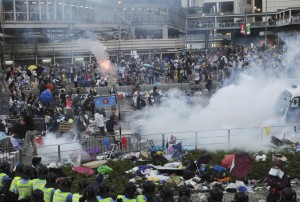
“(1) If any such assembly cannot be otherwise dispersed, and if it is necessary for public security that it should be dispersed, the Executive Magistrate of the highest rank who is present may cause it to be dispersed by the armed forces.
(2) The Magistrate may require any officer in command of any group of persons belonging to the armed forces to disperse the assembly with the help of the armed forces under his command, and to arrest and confine such persons forming part of it as the Magistrate may, direct, or as it may be necessary to arrest and confine in order to disperse the assembly or to have them punished according to law.
(3) Every such officer of the armed forces shall obey such requisition in such a manner as he thinks fit, but in doing so, he shall use as little force, and do as little injury to persons and property, as may be consistent with dispersing the assembly and arresting and detaining such persons.”
In the case, Re-Ramlila Maidan Incident v Home Secretary And Ors,[15]Personnel of the Rapid Action Force as well as the Central Reserve Police Force were called upon for dispersing the assembly of protestors gathered at Ramlila Maidan.
Section 131 states the power of certain armed force officers to disperse assembly.
“When the public security is manifestly endangered by any such assembly and no Executive Magistrate can be communicated with, any commissioned or gazetted officer of the armed forces may disperse such assembly with the help of the armed forces under his command, and may arrest and confine any persons forming part of it, in order to disperse such assembly or that they may be punished according to law, but if, while he is acting under this section, it becomes practicable for him to communicate with an Executive Magistrate, he shall do so, and shall henceforth obey the Magistrate as to whether he shall or shall not continue such action.”
Chapter VII of the Manual of Military law deals with the Duties of the military in aid of the civil power. Section 3[16] defines unlawful assembly and riots, Section 4[17] deals with the dispersal of unlawful assemblies and Section 5[18] Specifies the possibility of the use of force for dispersal of such assemblies.
Section 6 states the role of the military in the dispersal of unlawful assemblies. It reads as follows:
“When the civil authorities are incapable of dispersing such an unlawful assembly by the use of all the resources at their disposal, they can seek the aid of the armed forces, if it is necessary for the public security that such assembly should be dispersed. The executive magistrate of the highest rank who is present may cause it to be dispersed by the armed forces (Cr PC, 1973. s. 130(1)).”
- Protection against prosecution for acts done under preceding sections.
“(1) No prosecution against any person for any act purporting to be done under Section 129, Section 130 or Section 131 shall be instituted in any Criminal Court except-
(a) with the sanction of the Central Government where such person is an officer or member of the armed forces;
(b) with the sanction of the State Government in any other case.
(2) (a) no Executive Magistrate or police officer acting under any of the said sections in good faith;
(b) no person doing any act in good faith in compliance with a requisition under Section 129 or Section 130;
(c) no officer of the armed forces acting under Section 131 in good faith;
(d) no member of the armed forces doing any act in obedience to any order which he was bound to obey,
Shall be deemed to have thereby, committed an offense.
(3) In this section and the preceding sections of this Chapter, –
(a) the expression “armed forces” means the military, naval and air forces, operating as land forces and includes any other Armed Forces of the Union so operating;
(b) “Officer,” about the armed forces, means a person commissioned, Gazetted or in pay as an officer of the armed forces and includes a junior commissioned officer, a warrant officer, a petty officer of’ the armed forces a non-commissioned officer and a non-Gazetted officer.
(c) “member” about the armed forces, means a person in the armed forces other than an officer.”
In the case, Nagraj vs. State of Mysore,[19] the appellant, a sub-inspector accused of using force wrongfully against an assembly, claimed that the assembly was unlawful and that he would receive protection under Section 130 of the Code of Criminal Procedure. The Sessions Court made a reference for quashing of the commitment, stating that a Magistrate could not have taken cognizance of these offences in the absence of a sanction from the State Government with reference to positions the provisions of Sections 132 and 197[20]of the Code of Criminal Procedure. The High Court rejected this reference for quashing of the commitment order given by the Sessions Judge and allowed the appeal, allowing the sub-inspector to use the protection offered under this section.
Use of Force
The principle governs the use of force both in law as well as in police procedures that force should be used only when necessary; even then it should be minimum as well as in proportion to the circumstances and situation. It should also be discontinued immediately when the danger to life and as well as to property subsides.
The United Nations standards bind India on account of being a member. These standards form the basis of several laws. The United Nations Basic Principles[21] state that the use of force for dispersal of non-violent unlawful assemblies must be avoided and minimum force must be used if unavoidable. Only in the case of violent unlawful assemblies should firearms be used given that less dangerous means of dispersal are unavailable, this use of firearms should be to the minimum necessary extent. Model Rules on the use of force by the police against unlawful crowds as adopted by the Inspectors General of Police Conference, 1964[22] states “Minimum” necessary force should be used to achieve the desired object. Force should be regulated according to the circumstances of each case. The object of such use of force is to disperse the assembly and no punitive or repressive considerations should be operative while such force is being used.”[23]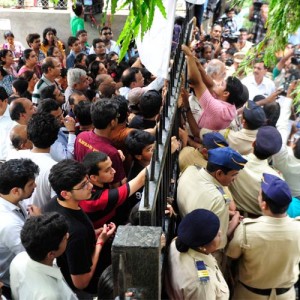
According to the law, only the executive magistrate or the officer- in-charge of a police station can order the use of force. It must resort to only against an unlawful assembly or one likely to disrupt public peace showing no signs of dispersal. The executive magistrate can also seek the assistance of armed forces to disperse such an assembly. Even in such cases, the force used by officers must be as little as possible and cause minimum possible injury to person and property in accordance with Section 99 of the Indian Penal Code specifying that in any case, harm more than necessary for defence cannot be caused since law enforcement agencies have right of private defence similar to ordinary people
The Police Code of Conduct[24] Specifies that method of persuasion, advice and warnings must be used as far as practicable. Only if it becomes unavoidable should force be used, and it must be the minimum required in the given situation and circumstances. The procedure governing the use of force has been outlined in the respective police manuals of different states. The Kerala Police Manual, 1970 contains a detailed step by step procedure with regards to the dispersal of unlawful assemblies.[25]
Prevention
Section 144[26] Of the Criminal Procedure Code deals with measures for prevention of unlawful assemblies. This section empowers Magistrates to prohibit the formation of unlawful assemblies of five or more persons. This power is given to prevent sudden outbreaks of rioting particularly by groups of armed persons that have a common motive of disrupting public peace and tranquillity.
On the passing of an order under Section 144, all concerned are expected to implement the order unless modified or rescinded by a forum having competent jurisdiction. One consequence of its implementation is dispersal of an unlawful assembly, if required, then by use of permissible force. An order passed under Section 144 applies to both an ‘actual’ unlawful assembly as well as to a ‘potential’ unlawful assembly. This is the scope of application as well as enforcement orders passed under this section.
[divider]
Footnotes:
[1]Constitution of India, Act 1 of 1949 §19(1)(b), “All citizens have the right to assemble peacefully and without arms. This right is subject to reasonable restrictions in the interest of the sovereignty and integrity of India and public order.”
[2]Indian Penal Code, Act 45 of 1860 § 141,“Unlawful assembly.—An assembly of five or more persons is designated an “unlawful assembly” if the common object of the persons composing that assembly is—
(First) — To overawe by criminal force, or show of criminal force, 1[the Central or any State Government or Parliament or the Legislature of any State], or any public servant in the exercise of the lawful power of such public servant; or
(Second) — To resist the execution of any law, or of any legal process; or
(Third) — To commit any mischief or criminal trespass, or other offense; or
(Fourth) — By means of criminal force, or show of criminal force, to any person, to take or obtain possession of any property, or to deprive any person of the enjoyment of a right of way, or of the use of water or other incorporeal right of which he is in possession or enjoyment, or to enforce any right or supposed right; or
(Fifth) — Using the criminal force, or show of criminal force, to compel any person to do what he is not legally bound to do, or to omit to do what he is legally entitled to do.
Explanation.—An assembly which was not unlawful when it assembled, may subsequently become an unlawful assembly.”
[3]Amar Singh and Ors v. the State of Punjab, AIR 1987 SC 826.
[4]Indian Penal Code, Act 45 of 1860 § 148, “Rioting, armed with deadly weapon.—Whoever is guilty of rioting, being armed with a deadly weapon or with anything which, used as a weapon of offence, is likely to cause death, shall be punished with imprisonment of either description for a term which may extend to three years, or with fine, or with both.”
[5]Indian Penal Code, Act 45 of 1860 § 149, “Every member of unlawful assembly guilty of offence committed in prosecution of common object.—If an offence is committed by any member of an unlawful assembly in prosecution of the common object of that assembly, or such as the members of that assembly knew to be likely to be committed in prosecution of that object, every person who, at the time of the committing of that offence, is a member of the same assembly, is guilty of that offence.”
[6]LallanRai and Ors v. the State of Bihar, 1962 Supp. (3) SCR 848.
[7]Indian Penal Code, Act 45 of 1860 § 425, “Mischief.—Whoever with intent to cause, or knowing that he is likely to cause, wrongful loss or damage to the public or to any person, causes the destruction of any property, or any such change in any property or in the situation thereof as destroys or diminishes its value or utility, or affects it injuriously, commits “mischief”. Explanation 1.—It is not essential to the offense of mischief that the offender should intend to cause loss or damage to the owner of the property injured or destroyed. It is sufficient if he intends to cause, or knows that he is likely to cause, wrongful loss or damage to any person by injuring any property, whether it belongs to that person or not. Explanation 2.—Mischief may be committed by an act affecting property belonging to the person who commits the act, or to that person and others jointly.”
[8]Indian Penal Code, Act 45 of 1860 § 441, “Criminal trespass.—Whoever enters into or upon property in the possession of another with intent to commit an offence or to intimidate, insult or annoy any person in possession of such property, or having lawfully entered into or upon such property, unlawfully remains there with intent thereby to intimidate, insult or annoy any such person, or with intent to commit an offence, is said to commit “criminal trespass”.”
[9] Indian Penal Code, Act 45 of 1860 § 40, “…the word “offense” denotes a thing punishable under this Code, or under any special or local law as from now on defined. And in sections 141, 176, 177, 201, 202, 212, 216 and 441, the word “offence” has the same meaning when the thing punishable under the special or local law is punishable under such law with imprisonment for a term of six months or upwards, whether with or without fine.”
[10]Indian Penal Code, Act 45 of 1860 § 97, “Right of private defense of the body and property.—Every person has a right, subject to the restrictions contained in section 99, to defend—
(First) — His body, and the body of any other person, against any offense affecting the human body;
(Secondly) —The property, whether movable or immovable, of himself or any other person, against any act which is an offense falling under the definition of theft, robbery, mischief or criminal trespass, or which is an attempt to commit theft, robbery, mischief or criminal trespass.”
[11]Indian Penal Code, Act 45 of 1860 § 106, “Right of private defence against deadly assault when there is risk of harm to innocent person.—If in the exercise of the right of private defence against an assault which reasonably causes the apprehension of death, the defender be so situated that he cannot effectually exercise that right without risk of harm to an innocent person, his right of private defence extends to the running of that risk.”
[12]Indian Penal Code, Act 45 of 1860 §143, “Whoever is a member of an unlawful assembly shall be punished with imprisonment of either description for a term which may extend to six months, or with fine, or with both.”
[13]Nagraj v the State of Mysore, 1964 AIR 269.
[14]RamlilaMaidan Incident vs.Home Secretary, Union of India (UOI) and Ors., (2012)5SCC1, 2012CriLJ3516.
[15]See id.
[16]Manual of Military Law § 3, “Unlawful assembly and riot. —Before examining the nature and extent of aid required to be rendered by the Army for the maintenance of law and order, it would be useful to know the technical meaning of the terms “unlawful assembly” and “riot.”
Unlawful assembly.—An assembly of five or more persons whose common object is to—
(a) overawe by criminal force, or show of criminal force, the Central or any State Government or Parliament or the Legislature of any State or any public servant in the exercise of his lawful power; or
(b) resist the execution of law or any legal process; or
(c) commit any mischief or criminal trespass, or other offense; or
(d) obtain possession of any property or to stop a right of way or to prevent lawful use of water or to enforce any right or supposed right against any person in enjoyment of such property or thing, by means of criminal force or show of criminal force; or
(e) compel any person to do what he is not legally bound to do, or to omit to do what he is legally entitled to do, using criminal force or show of criminal force.
An assembly which was not unlawful when it assembled may subsequently become an unlawful assembly (IPC.s.141),
A person who being aware of the facts which render an assembly unlawful intentionally joins it or continues in it is said to be a member of an unlawful assembly (IPC.s.142).
Riot. —Whenever force or violence is used by an unlawful assembly or by any member thereof, in the prosecution of the common object of such assembly, it becomes a riot (IPC.s.146).”
[17]Manual of Military Law § 4, “Dispersal of unlawful assemblies. —The law governing the dispersal of unlawful assemblies is contained in Chapter X (ss. 129 to 132) of the Cr PC, 1973 (2 of 1973). Any executive magistrate or officer in charge of a police station or, in the absence of such officer-in-charge, any police officer, not below the rank of a sub-inspector may command any unlawful assembly or any assembly of five or more persons likely to cause a disturbance of the public peace, to disperse; and it becomes the duty of every member of such an assembly to disperse accordingly (Cr PC, 1973. s. 129 (1)).”
[18]Manual of Military Law § 5, “Use of force to disperse unlawful assemblies. —If, upon being so commanded, any such assembly does not disperse, or if, without being so commanded, it conducts itself in such a manner as to show a determination not to disperse, any executive magistrate or officer in charge of police station referred to in para 4 above, may proceed to disperse such assembly by force, and may require the assistance of any male civilian for the purpose of dispersing such assembly and, if necessary, for arresting and confining the persons who form part of it, in order to disperse such assembly or that they may be punished according to law (Cr PC, 1973. s. 129(2)).”
[19]See supra, note 13.
[20]Code of Criminal Procedure, 1973 § 197, “Prosecution of Judges and public servants…”
[21]U.N Basic Principles for the Use of Force and Firearms, § 13, 14.
[22]Commonwealth Human Rights Initiative, Standards and Procedure for Crowd Control, July 2005, available at http://www.humanrightsinitiative.org/programs/aj/police/papers/standard_procedure_for_crowd_control.pdf
[23] Model Rules on the use of force by the police against unlawful crowds.
[24]Code of Conduct for the Police in India, Principle 4.
[25]Kerala Police Manual, 1970, “The police must invariably secure the presence of a magistrate where it anticipates a breach of peace
- The decision to use force and the type of force to be used is to be taken by the magistrate
- Once the magistrate gives the order for the use of force, the extent of force to be used will be determined by the senior-most police officer
- The extent of force used must be subject to the principle of minimum use of force
- Use of force should be progressive ñ i.e.; firearms must be used as a last resort if tear smoke and lathi charge fail to disperse the crowd
- Common tear smoke which causes no bodily injury and allows recovery of affected persons should be used
- When the crowd is large, and the use of tear smoke is likely to serve no useful purpose, the police may resort to lathi charge
- Lathi charge can only begin if the crowd refuses to disperse after suitable warning
- A Clear warning of the intention to carry out a lathi charge should be given through a bugle or whistle call in a language understood by the crowd. If available, a riot flag must be raised. If the police officer-in-charge is satisfied it is not practical to give a warning, s/he may order a lathi charge without warning.
- Lathi blows should be aimed at soft portions of the body and contact with the head or collarbone should be avoided as far as practicable
- The lathi blows must not cease until the crowd is completely dispersed
- If the crowd fails to disperse through the lathi charge, the magistrate or the competent officer may order firing
- The fullest warning in a clear and distinct manner must be given to the crowd to inform them that the firing will be effective
- If after the warning, the crowd refuses to disperse the order to fire may be given
- The police are not on any account allowed to fire except on a command is given by their officer. A warning shot in the air or firing over the heads of the crowd is not permitted.
- An armed force should maintain a safe distance from a dangerous crowd to prevent being overwhelmed, or increasing the chances of inflicting heavy casualties
- Aim should be kept low and directed at the most threatening part of the crowd
- Firing should cease the moment the crowd shows signs of dispersing
- All help should be rendered to convey the wounded to the hospital
- Police officers must not leave the scene of disturbance before satisfying themselves beyond reasonable doubt about the restoration of tranquillity.
- The police should maintain an accurate diary of all incidents, orders, and action along with the time of occurrence. This will include an individual report by all officers involved in the firing.
- The number of fired cartridges and the balance of unfired cartridges should be verified to ensure ammunition is accounted for.”
[26]Code of Criminal Procedure,1973 § 144,”Power to issue the order in urgent cases of nuisance of apprehended danger.
(1) In cases where, in the opinion of a District Magistrate, a Sub- Divisional Magistrate or any other Executive Magistrate specially empowered by the State Government in this behalf, there is sufficient ground for proceeding under this section, and immediate prevention or speedy remedy is desirable, such Magistrate may, by a written order stating the material facts of the case and served in the manner provided by section 134, direct any person to abstain from a certain act or to take certain order with respect to certain property in his possession or under his management, if such Magistrate considers that such direction is likely to prevent, or tends to prevent, obstruction, annoyance or injury to any person lawfully employed, or danger to human life, health or safety, or a disturbance of the public tranquility, or a riot, of an affray.”
 Serato DJ Crack 2025Serato DJ PRO Crack
Serato DJ Crack 2025Serato DJ PRO Crack


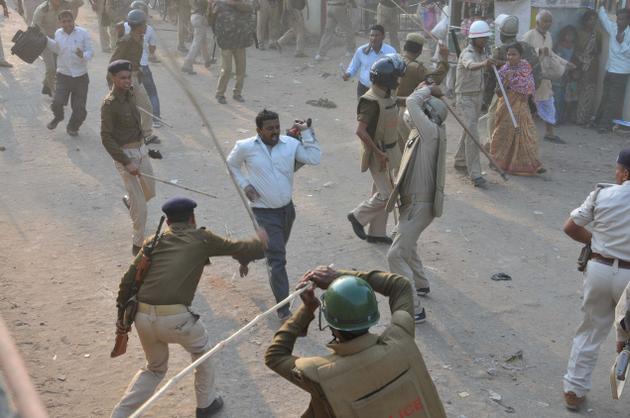







 Allow notifications
Allow notifications



